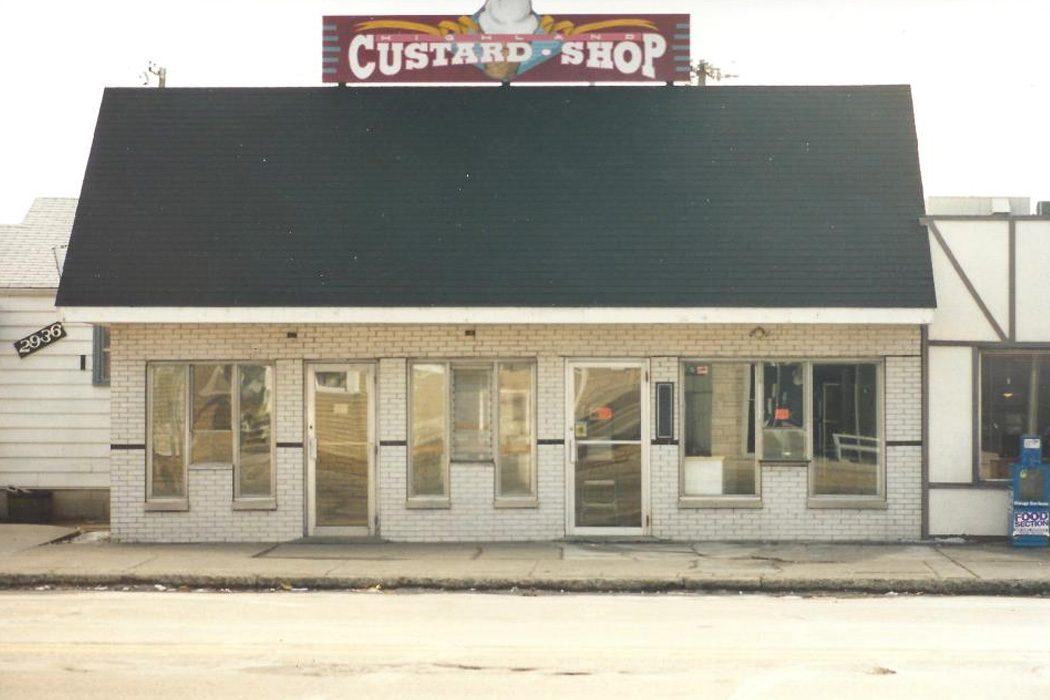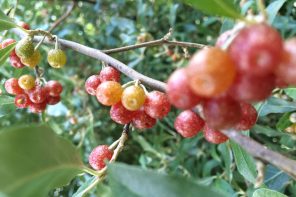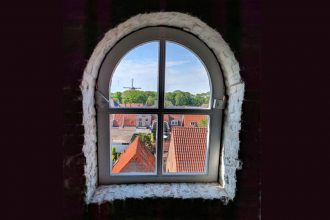My Saturday takes me round-trip. I start the morning with a volunteer shift in the downtown fair trade store my husband and I helped start in 2003, catching up on odds and ends, doing some reorganizing in our kitchenette area, and chatting with Lee and Ruth, Nicole and Sam, Bruce and Margaret, Richard and Brian.
Then, carpooling with my friend Deborah, I drive out to the country west of town. It’s the last regular day of the season for the Corey Lake Orchards farm stand and we stock up on apples, onions, eggs, squash, muffins, and cider (soft and hard). On a remarkably warm day for early November with a pristine blue sky, an entire extended family has gathered around the farm’s playground equipment, the kids taking turns on a tall, metal slide that would be banished from today’s school playgrounds—the same one I gleefully enjoyed as a kid visiting the farm with my grandma. I briefly exchange information about the upcoming election with my friend Becca while her dog Jordy alternately licks the apple core in my hand and reaches for the mystery goo that’s stuck to the sidewalk. I overhear advice on an apple variety I haven’t tried before, which is corroborated by my friend Peggy, who works at the stand.
From the fresh, grape-and-apple-scented air of the farm stand, Deborah and I head back into town for what’s supposed to be a quick stop at one of the local big box stores. Inside the humongous, climate-controlled pole barn, I can’t find the almond paste and no one I ask seems to know what I’m talking about, though the person at the sample stand does call me “honey” with a kind voice. I run into someone from my choral group while I’m taking way too long to “pick up a few things” as various as plastic storage containers and organic half-and-half.
After a (for real) quick stop at Bullseye, a small, locally-owned market that’s our go-to for bulk spices and donuts, we return downtown where I drop Deborah off and get to work pouring off apple cider into half gallons for freezing and transferring the fair trade store’s bulk tea to the new containers—one of which has a broken handle, which means yet another trip to the box.
As a resident and co-founder of a store in a historic, Midwest downtown district that’s about half empty, I’ve been part of many conversations over the past thirteen years about how we might revive our city center. Inevitably, these conversations drift toward “the way things used to be.” I didn’t experience downtown Three Rivers in the early twentieth century, but I did grow up in a Chicago suburb that still had a distinct downtown, catching the tail end of what many would consider the golden age.
I remember trying on matching Easter dresses with my sisters at the Highland Kiddie Shop, and going to the Highland Department Store, owned by my great-uncle, for school shoes as each summer came to a close. The year that I made the transition to women’s sizes, I picked out maroon suede loafers with a silver buckle accent, size 6. The department store is where half my family worked, as clerks or doing renovations, and where I got my first bra in the teen section.
I remember the Highland Pharmacy, an earlier version of Walgreens with a little bit of everything to browse while you got your prescriptions filled, and across the parking lot, the bank with the high curb where my great grandma, who didn’t drive and lived within walking distance of downtown, fell and broke her hip.
And there was the Highland Custard Shop, where my softball team would go for treats after the game, spending dollar tickets on candy and ice cream. Being able to bike to the Custard Shop by myself to meet my friend Kim for lunch was a symbol of growing up and the freedom that came along with it. I don’t think I knew it when I was a kid, but I loved that downtown—the open square, the public library, the bookstore, the bakery, the paint store, the sledding hill, and especially the old movie theatre that would serve cake at intermission and run a single movie as long as people kept coming (I’m guessing the all-time record was held by My Big Fat Greek Wedding).
At some point the department store succumbed to the likes of the new Kohl’s that popped up along with acres of strip malls on the family farm south of town where I used to play, and my great uncle’s family business turned to oil changes and porta-potties. A thrift store and a plumber now occupy portions of the old space, and I experience a distinct cognitive dissonance sorting through used paper backs in the exact spot where a clerk who knew me by name used to measure my foot. Niko’s, the breakfast dive of choice for my family, has a new owner and a new name. The theatre, now owned by the town, is somewhere in the renovation process, and a fancy vintage neon signs beckons drivers to take a soft right into the downtown, rather than speeding through on the overpass. According to a Highland Main Street Facebook page, the Hoosier Highlander, a 70-year-old stationery store, is up for sale, and public art is being employed like a new spark plug to get the engine going again.
I understand firsthand the nostalgia that comes into play as we try to figure out what the next phase of life looks like for downtowns that are no longer relevant in the same way they were 50 years ago. Many people seem to understand intuitively the value of small, locally-owned shops for weaving the fabric of relationship in a community. But I think we need to be careful about which period of history—and which version of the future—we uphold as the ideal. Does our plan cater only to the wealthy or is there something for everyone? Does it contribute to healing the racial oppressions of the past or does it further entrench the divides and inequities? Does it acknowledge in some concrete way that history did not begin with the Industrial Revolution and that the people who were here before white settlers had other means of cultivating deep relationships with one another and with the earth besides choosing the local hardware store over Home Depot? At our most recent weekly Friday potluck, our friend Elisabeth shared how she recently learned that the Sauk Trail that runs from Detroit to Chicago, passing through both where I grew up and where I live now, was originally created by mastodons. It became a game trail used by Native Americans and now, as U.S. 12, it’s the main drag through nearby Sturgis, Michigan. Sturgis, which is going through an enviable revival, has prehistoric elephants to thank for the commercial path forged between two Great Lakes.
In spite of the apparently mammoth origins and the oft-repeated story about how my grandpa’s bike was stolen while my uncle watched it (I suspect there’s another side to this tale), I felt safe in downtown Highland. As I browsed the clothing in the clearance section in the Department Store after riding my bike downtown—and locking it!—I had a distinct sense of myself growing up into the person I was pre-programmed to be: a savvy shopper, looking for a bargain on something cute, with money in my purse and an air of entitlement as a great-niece of the family empire. It wasn’t until many years later that I thought to consider who didn’t feel safe in downtown Highland, and whose stories of the past in that place I wasn’t hearing.
I may have missed my opportunity to ask these kinds of questions in my hometown, but I hope I can do better in the place I plan to live out my adult life. It won’t be easy. I don’t want to think about how both the farms I love and the big box stores alike make their money on stolen land. But if I don’t consider such things—if we don’t as a community—then the future will only be a distorted reflection of an incomplete past, a façade to hide the crumbling narratives of our places and ourselves.





